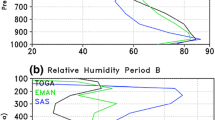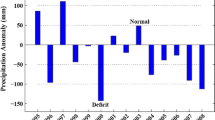Abstract
A new closure and a modified detrainment for the simplified Arakawa–Schubert (SAS) cumulus parameterization scheme are proposed. In the modified convective scheme which is named as King Abdulaziz University (KAU) scheme, the closure depends on both the buoyancy force and the environment mean relative humidity. A lateral entrainment rate varying with environment relative humidity is proposed and tends to suppress convection in a dry atmosphere. The detrainment rate also varies with environment relative humidity. The KAU scheme has been tested in a single column model (SCM) and implemented in a coupled global climate model (CGCM). Increased coupling between environment and clouds in the KAU scheme results in improved sensitivity of the depth and strength of convection to environmental humidity compared to the original SAS scheme. The new scheme improves precipitation simulation with better representations of moisture and temperature especially during suppressed convection periods. The KAU scheme implemented in the Seoul National University (SNU) CGCM shows improved precipitation over the tropics. The simulated precipitation pattern over the Arabian Peninsula and Northeast African region is also improved.









Similar content being viewed by others
References
Arakawa A, Schubert WH (1974) Interaction of a cumulus ensemble with the large-scale environment, part I. J Atmos Sci 31:674–704
Barkidija S, Fuchs Z (2013) Precipitation correlation between convective available potential energy, convective inhibition and saturation fraction in middle latitudes. Atmos Res 124:170–180
Behringer DW, Xue Y (2004) Evaluation of the global ocean data assimilation system at NCEP: the Pacific Ocean In: Eighth symposium on integrated observing and assimilation systems for atmosphere, ocean, land surface. AMS 84th annual meeting, Seattle, Washington, 11–15 Jan
Bechtold P, Bazile E, Guichard F, Mascart P, Richard E (2001) A mass flux convection scheme for regional and global models. Q J R Meteorol Soc 127:869–886
Bechtold P, Kohler M, Jung T, Doblas-Reyes F, Leutbecher M, Rodwell MJ, Vitart F, Balsamo G (2008) Advances in simulating atmospheric variability with the ECMWF model: from synoptic to decadal time-scales. Q J R Meteorol Soc 134:1337–1351
Bechtold P et al. (2014) Representing equilibrium and non equilibrium convection in large-scale models. J Atmos Sci 71:734–753
Böing SJ, Siebesma AP, Korpershoek JD, Jonker HJJ (2012) Detrainment in deep convection. Geophys Res Lett 39:L20816. doi:10.1029/2012GL053735
Bonan GB (1996) The land surface climatology of the NCAR land surface model coupled to the NCAR community climate model. J Clim 11:1307–1326
Chikira M, Sugiyama M (2010) A cumulus parameterization with state-dependent entrainment rate. Part I: Description and Sensitivity to Temperature and Humidity Profiles J Atmos Sci 67:2171–2193
Derbyshire SH, Beau I, Bechtold P, Grandpeix JY, Piriou JM, Redelsperger JL, Soares PMM (2004) Sensitivity of moist convection to environmental humidity. Q J R Meteorol Soc 130:3055–3079
Derbyshire SH, Maidens AV, Milton SF, Stratton RA, Willett MR (2011) Adaptive detrainment in a convective parameterization. Q J R Meteorol Soc 137:1856–1871
De Rooy WC, Bechtold P, Fröhlich K, Hohenegger C, Jonker H, Mironov D, Siebesma AP, Teixeira J, Yano JI (2013) Entrainment and detrainment in cumulus convection: an overview. Q J R Meteorol Soc 139:1–19
Emanuel KA, Neelin JD, Bretherton CS (1994) On large-scale circulations in convecting atmospheres. Q J R Meteorol Soc 120:1111–1143
Gregory D (2001) Estimation of entrainment rate in simple models of convective clouds. Q J R Meteorol Soc 127:53–72
Holtslag AAM, Boville BA (1993) Local versus non-local boundary layer diffusion in a global climate model. J Clim 6:1825–1842
Kang HS, Hong SY (2008) Sensitivity of the simulated east Asian summer monsoon climatology to four convective parameterization schemes. J Geophys Res 113:D15119. doi:10.1029/2007JD009692
Kanamitsu M, Ebisuzaki W, Woollen J, Yang SK, Hnilo JJ, Fiorino M, Potter GL (2002a) NCEP–DOE AMIP-II reanalysis (R-2) dynamical seasonal forecast system 2000. Bull Amer Meteor Soc 83:1631–1643
Kim HM, Kang IS (2008) The impact of ocean–atmosphere coupling on the predictability of boreal summer intraseasonal oscillation. Clim Dyn 31:859–870
Kim D, Kang IS (2011) A bulk mass flux convection scheme for a climate model: description and moisture sensitivity. Clim Dyn 38:411–429
Kuang Z, Bretherton CS (2006) A mass-flux scheme view of a high resolution simulation of a transition from shallow to deep cumulus convection. J Atmos Sci 63:1895–1909
Kug JS, Kang IS, Choi DH (2007) Seasonal climate predictability with tier-one and tier-two prediction systems. Clim Dyn 31:403–416
Kuo YH (1974) Further studies of the parameterization of the influence of cumulus convection of large-scale flow. J Atmos Sci 31:1232–1240
Le Treut H, Li ZX (1991) Sensitivity of an atmospheric general circulation model to prescribed SST changes: feedback effects associated with the simulation of cloud optical properties. Clim Dyn 5:175–187
Lee MI, Kang IS, Mapes BE (2003) Impacts of cumulus convection parameterization on aqua-planet AGCM simulations of tropical intraseasonal variability. J Meteorol Soc Jpn 81:963–992
Moorthi S, Suarez MJ (1992) Relaxed Arakawa-Schubert. A parameterization of moist convection for general circulation models. Mon Weather Rev 120:978–1002
Neggers R, Siebesma A, Lenderink G, Holtslag A (2004) An evaluation of mass flux closures for diurnal cycles of shallow cumulus. Mon Weather Rev 132:2525–2538
Nakajima T, Tsukamoto M, Tsushima Y, Numaguti A (1995) Modelling of the radiative process in an AGCM. In: Matsuno T (ed) Climate system dynamics and modelling. vol. I–3. Univ. of Tokyo, Tokyo, pp. 104–123
Nordeng TE (1995) Extended versions of the convective parameterization scheme at ECMWF and their impact on the mean and transient activity of the model in the tropics. European Centre for Medium-Range Weather Forecasts
Noh Y, Kim HJ (1999) Simulations of temperature and turbulence structure of the oceanic boundary layer with the improved near surface process. J Geophys Res 104:15621–15634
Numaguti A, Takahashi M, Nakajima T, Sumi A (1995) Development of an atmospheric general circulation model. In: Matsuno T (ed) climate system dynamics and modelling, vol. I–3. Univ. of Tokyo, Tokyo, pp. 1–27
Picaut J, Hackert E, Busalacchi AJ, Murtugudde R, Lagerloef GSE (2002) Mechanisms of the 1997–1998 El Niño–La Niña, as inferred from space-based observations. J Geophys Res 107(C5). doi:10.1029/2001JC000850
Randall DA, Xu KM, Somerville RJC, Iacobellis S (1996) Single column models and cloud ensemble models as links between observations and climate models. J Clim 9:1683–1697
Randall DA, Curry J, Duynkerke P, Krueger S, Miller M, Moncrieff M, Ryan B, Starr D, Rossow W, Tselioudis G, Wielicki B (2000) The second GEWEX cloud system study science and implementation plan. IGPO Publ Ser 34:45
Simpson J, Wiggert V (1969) Models of precipitating cumulus towers. Mon Weather Rev 97:471–489
Taylor KE (2001) Summarizing multiple aspects of model performance in a single diagram. J Geohys Res 106:7183–7192
Tiedtke M (1984) The sensitivity of the time-mean large-scale flow to cumulus convection in the ECMWF model. 297–316.
Tiedtke M (1989) A comprehensive mass flux scheme for cumulus parameterization in large-scale models. Mon Weather Rev 117:1779–1800
Webster PJ, Lukas R (1992) TOGA COARE: the coupled ocean atmosphere response experiment. Bull Am Meteorol Soc 73:1377–1416
Wu CM, Stevens B, Arakawa A (2008) What controls the transition from shallow to deep convection? J Atmos Sci 66:1793–1806
Yang YM, Kang IS, Almazroui M (2014) A mass flux closure function in a GCM based on the Richardson number. Clim Dyn 42:1129–1138
Yano JI, Bister M, Fuchs Z, Gerard L, Phillips V, Barkidija S, Piriou JM (2013b) Phenomenology of convection-parameterization closure. Atmos Phys Chem 13:4111–4131
Zhang GJ (2002) Convective quasi-equilibrium in midlatitude continental environment and its effect on convective parameterization. J Geohys Res 107. doi:10.1029/2001JD001005
Zhang GJ, McFarlane NA (1995) Sensitivity of climate simulations to the parameterization of cumulus convection in the Canadian climate centre general circulation model. Atmosphere-Ocean 33:407–446
Zhang GJ, Mu M (2005) Effects of modifications to the Zhang-McFarlane convection parameterization on the simulation of the tropical precipitation in the national center for atmospheric research community climate model, version 3. J Geophys Res 110:1–12
Acknowledgments
The authors would like to acknowledge the Center of Excellence for Climate Change Research (CECCR), Department of Meteorology, Deanship of Graduate Studies and Deanship of Scientific Research, King Abdulaziz University (KAU), Jeddah, Saudi Arabia, for providing the necessary support to carry out this study. We thank anonymous reviewer for making insightful comments that lead to substantial improvements in the final version of the paper. Computation for the work described in this paper was supported by King Abdulaziz University’s High Performance Computing Center (Aziz Supercomputer: http://hpc.kau.edu.sa).
Author information
Authors and Affiliations
Corresponding author
Rights and permissions
About this article
Cite this article
Elsayed Yousef, A., Ehsan, M., Almazroui, M. et al. An improvement in mass flux convective parameterizations and its impact on seasonal simulations using a coupled model. Theor Appl Climatol 127, 779–791 (2017). https://doi.org/10.1007/s00704-015-1668-7
Received:
Accepted:
Published:
Issue Date:
DOI: https://doi.org/10.1007/s00704-015-1668-7




